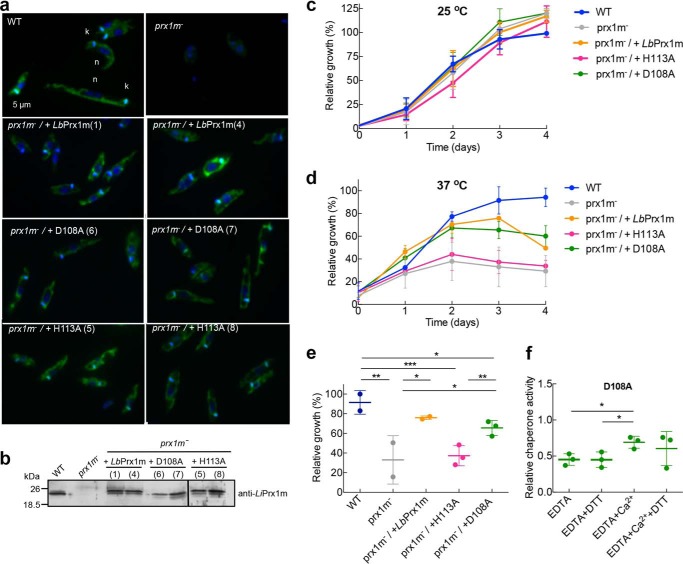Figure 10.
Leishmania growth at 37 °C depends on Prx1m decamerization. a, indirect immunofluorescence of L. infantum (WT), L. infantum knock-out for LiPrx1m (prx1m−), and prx1m− complemented with LbPrx1mH113A (clones 5 and 8), LbPrx1mD108A (clones 6 and 7), and WT LbPrx1m (clones 1 and 4). Parasites were incubated with anti-Prx1m antibody (green) and merged with DAPI (blue) (n, nucleus; k, kinetoplast). b, Western blotting analysis using anti-LiPrx1m antibody (53) of L. infantum WT, prx1m−, and the transfectants. A total of 20 μg of protein extracts were loaded per lane. Leishmania growth curves at 25 °C (c) and 37 °C (d) for WT, prx1m−, and transfectants. The experiments were performed in duplicate for L. infantum WT and prx1m− and in triplicate for the transfectants. e, statistical analysis of Leishmania relative growth at 37 °C considering the day 3 representation in d. *, p < 0.1; **, p < 0.05; ***, p < 0.01. f, in vitro chaperone activity of mutant D108A in the presence of 5 mm EDTA or 5 mm EDTA followed by the addition of 25 mm CaCl2, with or without 2 mm DTT, in Tris buffer (pH 7.5) (*, p < 0.1). All experiments were performed in triplicate. Relative activities were calculated with respect to the activity of WT protein in the presence of Ca2+ or Ca2+ plus DTT according to the absence or presence of DTT in the tested condition. Samples not treated with DTT are air-oxidized (S–S-bonded).

